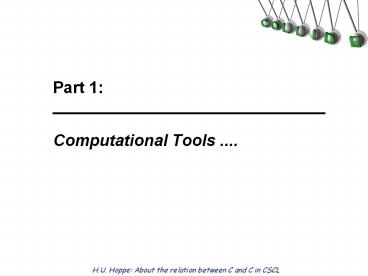Part 1: ______________________________ Computational Tools .... - PowerPoint PPT Presentation
1 / 20
Title: Part 1: ______________________________ Computational Tools ....
1
Part 1______________________________Computatio
nal Tools ....
2
Co-constructive tools____________________________
___________
3
Co-constructive tools____________________________
___________
4
CardBoard - a platform for shared visual
languages ________________________________________
_
Creation of workspaces
- Private and public workspaces
- flexibly definable visual languages
- content cards
- connectors representing relations
Record Replay
Visual languageframework
5
Syntax definition as a parameter_________________
________________________
External representation
Specification
Description SemanticType Conflict MenuEntry
Conflict Type connector_card Style
bitmap Content contra2.bmp ReadOnly
true Shape circle ShapeColor 0,0,0 Link
reference, Reference,1,,0,0,0 Link
contradiction, Contradiction,-1,,0,0,0
Internal representation
Card hierarchy Interpretation of attributes
6
Example turtle puzzle_________________________
___________
- Flexible mix of shared and private workspaces
- Replicated architecturesynchronisation of fully
functional autonomous applications (no master!) - Jigsaw design
- plug-in interface for internal virtual agents
(see below -gt ... )
Example Turtle puzzle with virtual player
7
Jigsaw design__________________________________
_______
from NIMIS classroom (-gt later)
8
Cooperation modes _______________________________
_________
teachercontrol
teacher students
9
Cooperation modes _______________________________
_________
teachercontrol
o
Animation how local results are propagated to
the publicly visible result workspace
teacher students
10
CSCL - contributions to C ______________________
________________
- Architectures replication, internal agents
- Designing for collaboration (jigsaw -gt Aronson,
1978) - Designing for flexible use -gt evolving patterns
of usage (Gassner) - representational engineering-gt mixed
semantics in visual languages-gt meta-level
analysis of representational bias (Suthers,
1999)
11
Part 2______________________________Modeling
and Understanding ....
12
ltGoalgt_______________________________________
13
ltGoalgt_______________________________________
14
The scenario_____________________________________
___
shared and private workspaces
visual languages
face-to-face situation
15
Semantic interpretation and action analysis
________________________________________
- Workspace(s)
- cards, card networks
- Mediator
- declarative reconstruction
- graph structure (cycles, hierarchy)
- spatial structure (topology, adjacency)
- temporal structure (sequence)
- Interpreter(s)
- logical model
- arithmetical model
- problem solving analysis
workspace
mediator
interpreter
16
Analysis of cooperative problem solving
(Mühlenbrock) ___________________________________
_____
Protocol
User 1
User 2
revision
Problem solving phases
17
Example analysis_________________________________
_______
18
Visualisation____________________________________
____
19
Evaluation schema________________________________
______
If we put thishere ...
... thatwill fitthere.
indexing
prediction?
Hmm.
action-based indicators
dialogue scenes
20
Formal analysis and modeling of group
interactions_____________________________________
___
- Open validate an ontology of group interactions
- Discourse analysis vs. action-based analysis?
- Background -gt AI work on plan recognition
reasoning about action -gt computational
mathetics (Self, 1995) -gt formal analysis of
human communication (Watzlawick et al.,
1967)































